The Chess Drum beats in Cuba!
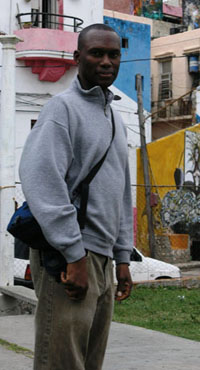
Cuba is the largest Caribbean island boasting a rich history and some of the most passionate people on the planet. It is part of this passion that has produced the creativity and ingenuity in a land of modesty. Cuba is a place full of many stories. There is the political story which many Cubans avoid discussing.
However, there is the social story which is thrust forward in everything from music and dance to painting and sculpture. It is for this reason that many U.S. academics and researchers find themselves in Cuba. I have always been interested in visiting Cuba. It was my hope that I would observe the political, economic and social makeup of the island and by doing so, I could develop a more informed view. To be honest, I was also interested in the chess marvel that Cuba is.
There are such provisions that allow such travel under “general license” and travel restrictions have eased a bit in the past year. Cuba is often discussed in Global Business textbooks that I teach out of with a particular emphasis on the embargo. It is quite an interesting history to study.
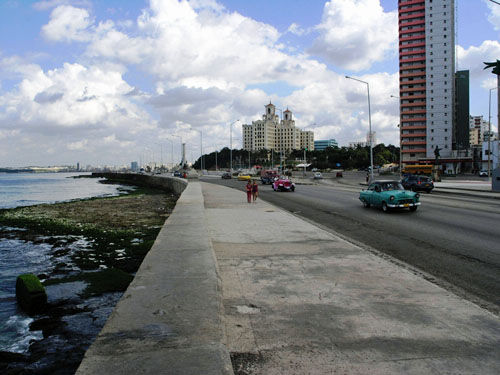
The famous Malecon of Cuba.

Commercial Bank in Old Havana… stunning Spanish architecture.
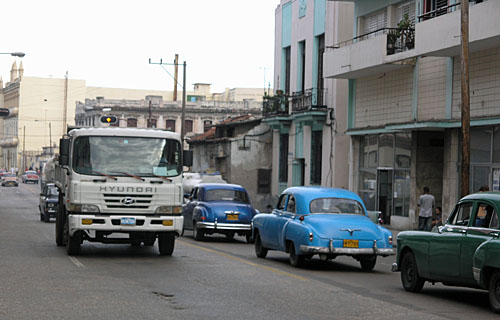
These antique cars are commonplace around Cuba.
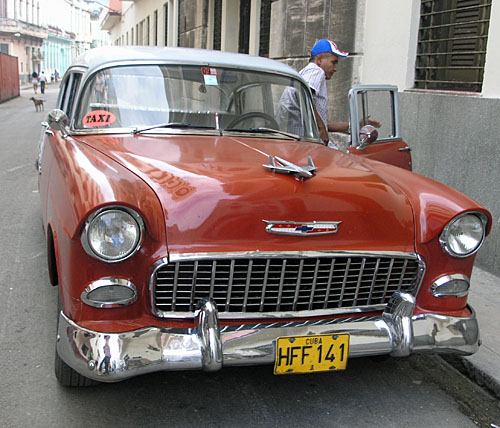
Look at this beauty!
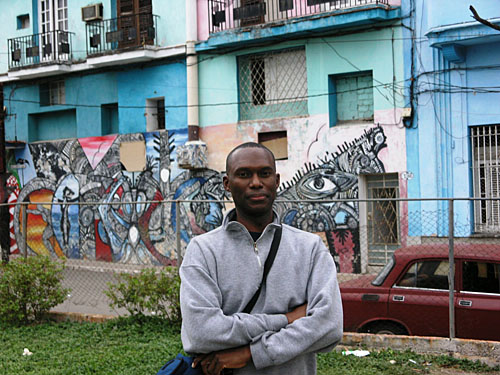
Me is the Hamel community, a tribute to Afro-Cuban art.
The Spanish architecture is also quite a marvel and many of the buildings are more than 100 years old. There are many statuesque buildings, but perhaps the greatest marvel are the antique automobiles, some of which are more than 50 years old. I spotted a couple of cars from the 1930s being used as taxis! Amazing. Amazing. The downside would be the poor air quality from the inefficient engines and the fact that a good percentage of Cubans smoke. Nevertheless, the famous Cohiba cigars remain a trademark of Cuba. However, Cuba is a relatively clean country as the streets are frequently hosed down.
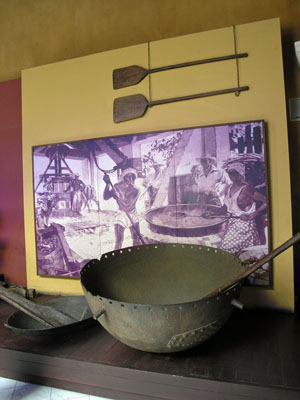
Slaves stirring the boiling sugar cane into the molasses to make rum.
I don’t drink alcoholic beverages, but I went to the rum factory and the Havana Club and learned how rum is produced through such an intricate fermentation and distillation process. I have been to similar tours of candy, wine, coffee, tobacco and soda. To me it is all a lesson in supply chain management and lessons I can pass onto my students. While I did not visit a coffee plantation in Cuba, I did drink quite a few cups of its strong brand.
The rum tour was interesting but bittersweet for me. The rum industry was essentially built off the backs of slave labor. After the Taino Indians were exterminated, powerfully-built slaves from Angola and other parts of Africa carried the brunt of the sugar production and made Cuba into a sugar powerhouse supplying the U.S. market until the ill-fated embargo. That sugar then went to the Soviet Union. Today, I would imagine that the sugar also goes into other products such as the delicious Baracoa dark chocolate bars.

One of the greatest pleasures of life… chocolate!

Reputably-strong Cuban coffee. Not a coffee drinker, but I had a few cups.
Many people in the U.S. are given a very narrow view of Cuba for political reasons. I will not go into the long and contentious history as it is well-known. What is actually Cuba like? While it is difficult to give an exhaustive account without more immersive study, socially the people are friendly, hard-working, disciplined, passionate and optimistic. Most days I was able to blend in and observe.

Yes… many revolutionary slogans and pictures of the sort, but Che’ Guevara is the dominant persona displayed.
When you look around Cuba, it appears to be a normal society not yet obsessed with cell phones and material possessions. Few people can afford these things, but many will explain the economic system with neither a hot nor cold attitude and seem to bear no animosity or jealousy toward the U.S. They are proud Cubans. Everything is relative.
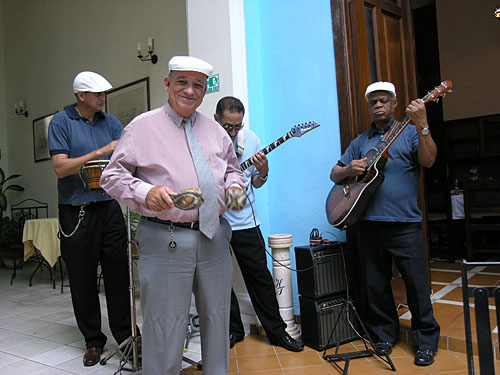
Los Cheveres… the leader singer had a wonderful voice!
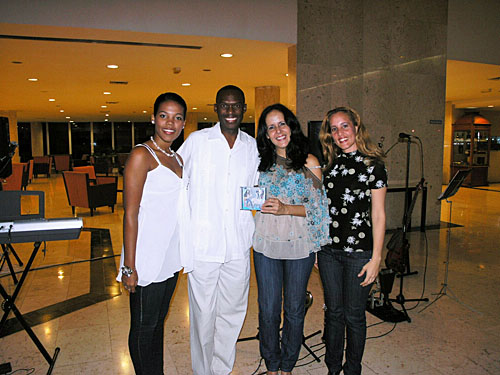
Me with Sol y Arena (Niuvys, Lisandra, Liliana) who performed at the Habana Libre Hotel. Lisandra is holding my autographed CD. Very talented trio!
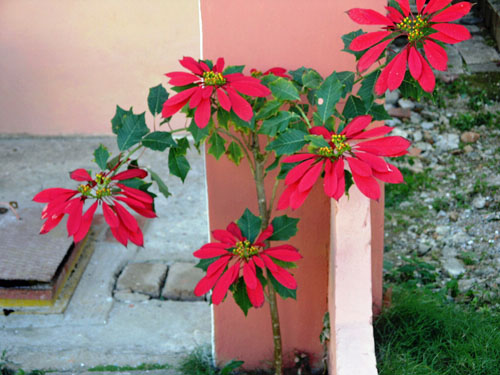
Poinsettas in the someone’s front yard.

Walking along the Malecon, I saw youth diving.
Looked like fun!
While the country has inherent beauty from the Caribbean Sea, beautiful architecture, tropical climate, there are the looming issues such as air pollution, broken sidewalks and buildings in disrepair. I rode buses while in Havana and they were sheer adventures to say the least.

Trying to get on a Havana bus is tough, but withstanding the fumes is another story.
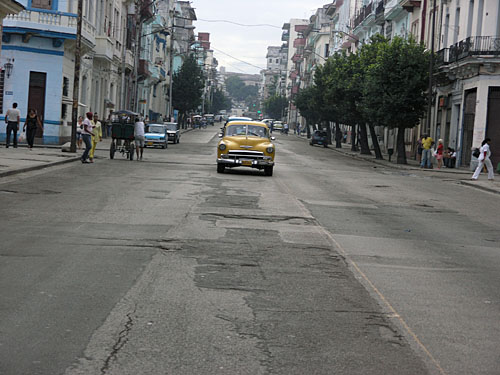
If not a bus, then you’d take a taxi. Better.
Growing up in Chicago, I was used to rush hour traffic with overcrowded buses. If the bus was overcrowded, you simply waited for the next one. However, in Cuba people did not relent if the bus was full and tried boarding for ten minutes. In addition, the door would not close, but the bus started off anyway. If you had to let someone off, you’d have to avoid losing your space as 25 more people would try to muscle their way on. At least it was not Japan where an attendant shoves you onto the train.
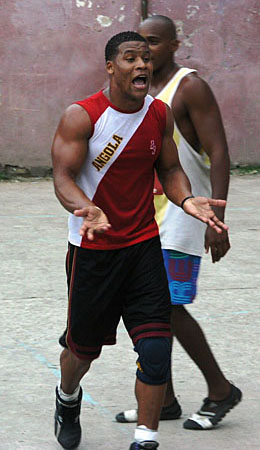
This man reminded me of Chicago Bulls superstar Derrick Rose… a bit more muscular. We passed by and saw a pickup game and were invited over. Cuban players were very competitive. Two U.S. guys I was with played and they split games.
There were many highlights on the trip, but of course one cannot go to Cuba without taking home a number of stories. Walking around Cuba, you will feel the electricity as pedestrians ambled throughout the streets and hordes waited for the buses and old taxis. The Cuban population is very diverse with seemingly upwards of 30% being Afro-Cuban or of African descent.
There was no way to tell if Blacks were relegated to the lower rungs as there was hardly any vagrancy and not much in the way of stereotypical jobs held by a certain racial class. Crime is apparently low in Cuba and I saw no incidences in my short visit. I had my big city instincts in tune. There was the occasional hustler who would try to set up dates with Cuban ladies, or someone who’d take you to a coffee shop or “Bueno Vista” bar only to leave you with the bill.
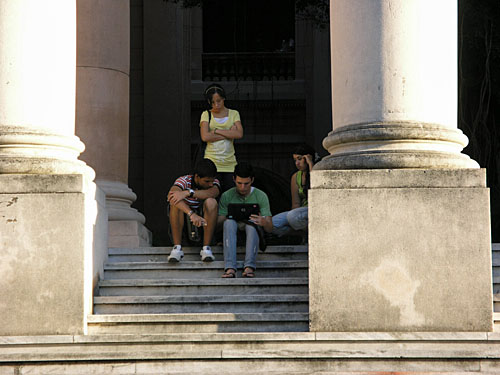
No hustling at the University of Havana… only hard work!
Cuba is a beautiful country with a lush countryside. Visiting the town of Vinielas was a treat and the cave excursion was a sight to behold. It was my first breath of fresh air for more than a week. My lungs had a respite from the exhaust fumes and cigarette smoke of Havana. It was also where I would finally get fresh-squeezed juices. Thus, I loaded up on guava and orange juices. Being a vegan/vegetarian is tough in Cuba and particularly in Havana. There are a couple of places, but Cuba is a place were meat reigns supreme… mostly pork. Ham/cheese sandwiches and ham/cheese or cheese pizza are popular street fare. Cuba’s cheese got rave reviews from visitors.
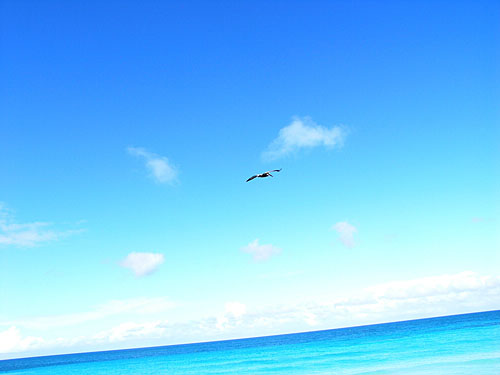
Free as a bird… a shot at the countryside beach.
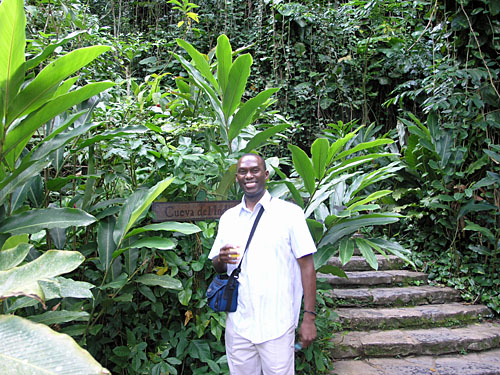
In the countryside, I had some fresh orange juice with freshly-squeezed sugar cane. A welcome respite from the imported juice in the cartons in Havana.
Ice cream is also popular. According to some of my travel mates the dairy products were REAL and much more flavorful. I can attest that the vegetables I had in Cuba tasted much better and were flavorful. I loved the maduros (sweet plantains)! Much better than the $4.10 for a canister of Pringles. The restaurants had primarily chicken, fish and pork. Beef was not as common.
The foods prepared are not spicy and pepper sauce is hard to come by. Nevertheless, fruit and vegetable vendors are commonplace on the streets. Food is relatively cheap in Cuba except at the hotels where the portions are rather modest and prices high since the CUC is on par with the U.S. dollar.
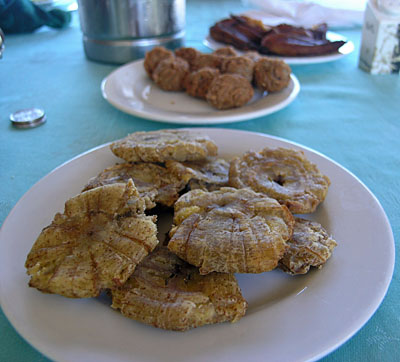
Delicacies found in Cuba… tostones, malanga, maduros!
There are two currencies in Cuba… the CUC for the visitors and the non-convertible peso for the locals. One CUC is worth 24 pesos. Visitors cannot use the local currency and the CUC is on par with (or slightly stronger than) the U.S. dollar. So for a U.S. visitor, everything is face value. Euros can be used in Cuba without a heavy tax, but I later learned that a visitor can change U.S. currency (in some places) for a hefty 10% tax. Changing U.S. currency is not a viable option and U.S. credit cards (if you can find a place accepting them) are assessed a 3% charge and are typically not used in Cuba.
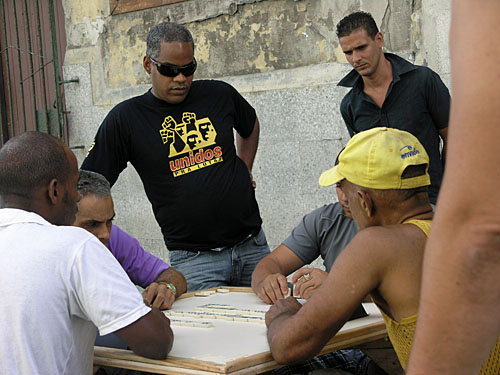
Dominoes! They didn’t slam the tiles like in Jamaica!
One trick one must learn is when locals ask you where you are from. Europeans have no escape, but Blacks can say they are from Jamaica or the Bahamas and the locals will make small talk and leave you on your way. Many of my fellow visitors said they were from Haiti and Jamaica. If you say you are from the U.S., then you get the tourist treatment which usually ends up with you spending money. Alas… it is like that in all countries.
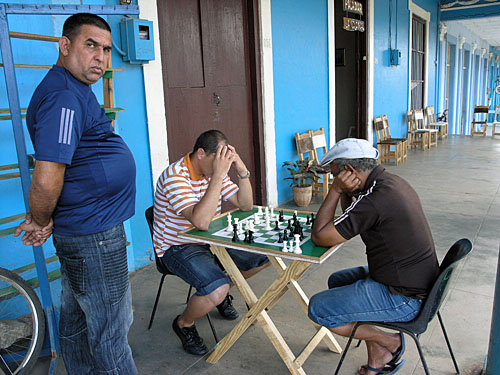
Skittles game in the afternoon.
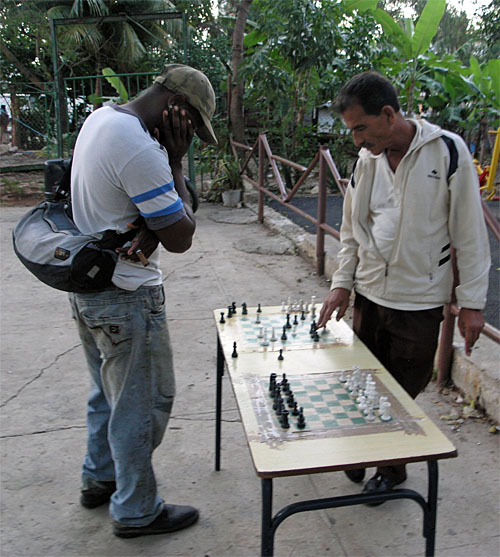
Another random chess game going on while passing through a neighborhood. Simul?
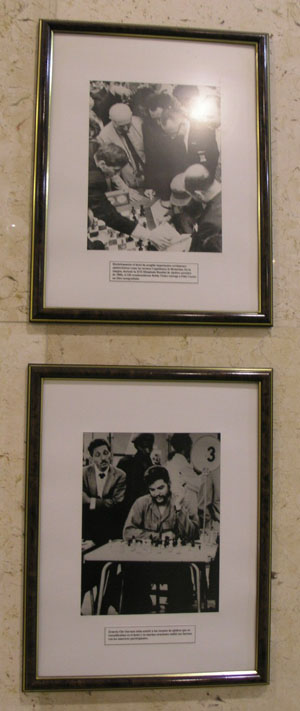
Finally, the appreciation for chess is great. Chess can be found to be integrated into Cuban culture and you see it in the artwork, in the museums, in the hotels, on the streets, in the markets and the image of Capablanca is sometimes seen. There is a fine painting of Capablanca in the National Hotel. The famous image of Bobby Fischer and Fidel Castro playing chess at the 1966 Olympiad is displayed at the Habana Libre on 23rd and L Street. Che Guevara is also seen playing in a simul. With such support for chess, it is no surprise that Cuba is one of the strongest chess nations on the planet.
Club Capablanca sits on Infanta Street and attended enthusiastically by local players. There were no sightings of Cuban Grandmasters Leinier Dominguez, Lazaro Bruzon or Yuniesky Quesada, but there was a lot of excitement despite the lack of resources and chess materials. I gave the chess club a 16-pack of Duracell AA batteries for their chess clocks.
I certainly quenched my chess thirst while in Cuba and it was the happiest I’ve been after losing my share of games. To be in Cuba during the memorial tournament of Rogelio Ortega was more than I could imagine. What an honor to be in the house of Capablanca! I left a few Drum t-shirts behind and a stash of Drum ink pens in Cuba.
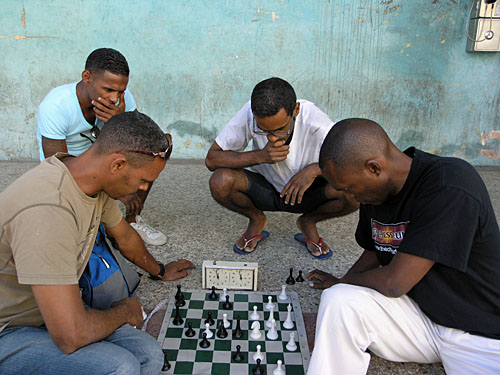
Chess games were easy to find in Cuba. I played a couple of blitz games on the street.
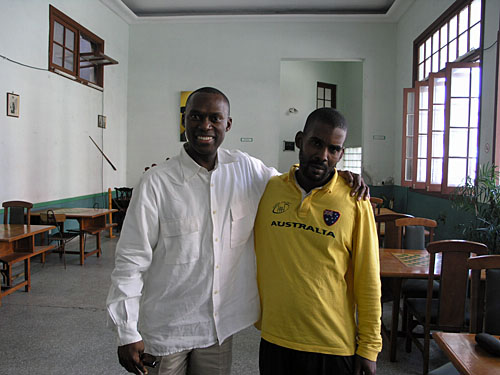
At the Club Capablanca with Vladimir Ferrer who hails from Santiago. Vladimir taught himself English and was comfortably fluent. We played a series of competitive and theoretical games. The games were level, but he was ultimately a few games up. Strong! Photo by Daaim Shabazz.

An animated analysis session!!
While I did not bring back much in the way of souvenirs, I did bring back enough memories to last a lifetime. Later I will list some of my most memorable moments (good and bad) in Cuba. The island is a treasure trove of history and traveling there is quite an education.
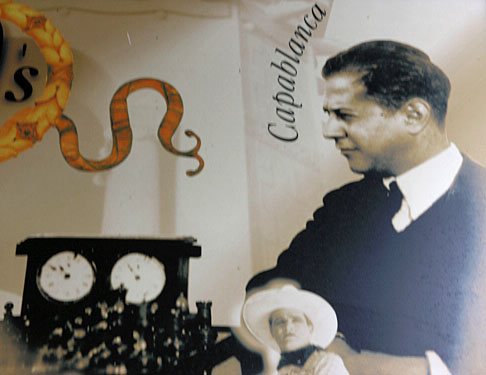
The man who started the Cuban chess craze…
World Champion Jose’ Raul Capablanca, 1921-1927.





Thank you for the memories and the great pictures.
Happy New Year!
Vernetta
Vernetta,
It was a great trip and memorable! I may put up more of them.
As-Salaam Alaikum Brother Daaim!
Beautiful article! My daughter, who we send of to the UIC dorms tomorrow, was initially supposed to go to the Latin American School of Medicine, in Cuba. There are several members of our community enrolled in the school, and Castro encourages students from throughout the world to come and enroll at no cost. My in-laws effectively killed her desire, telling her that Cuba was a violent country where women are sold into slavery. What was funny about their stories is none of them had been there! Your account of the place is much like others’ accounts who were there, which lets me know that everything else is propaganda.
I’m thankful for this article, because I can send it to my daughter, and maybe she might reconsider (UIC costs a pretty penny). All jokes aside, I was aware of the strong sense of culture in Cuba, but you really piqued my desire to actually go there. Did the Club Capablanca have any vintage game scores of Capablanca or Ernesto Guevara? It would have been interesting if you could have posted some. The pictures you captured were wonderful! Thank you for your profound insight!
Wa Laikum Salaam!
Yes sir. There is a lot of propaganda about Cuba and a lot of it is baseless. However, there are critics within Cuba (and here in the U.S.) who may have a more antagonistic view. From what I saw, Cuba was not the place often depicted in the American media and in political realm.
I have never heard about the slavery story. I DID see remnants of prostitution in Cuba. Cuban women solicit in some of the night clubs. I was told of stories by some of my travel mates about being “bum-rushed” by women who immediately tried to score a date. I was even approached in a posh hotel by a woman claiming to be a “masseuse” and asking me if I wanted a massage. There are also many methods to try to lure tourists into places to spend money. However, what nation does not have its unsavory elements? There is a red light district in walking distance from Wall Street.
Cuba is an interesting country… one of a turbulent history, but one of where pride is high and potential is great. Your in-laws may have been reading propaganda stories. I’m not sure what level of knowledge they have. In terms of the study of medicine, Cuba has a good reputation of producing world-class doctors and the students are serious. I was on the campus of University of Havana and the mood is certainly studious. They are not engrossed in cellphones yet, but there is quite a bit of smoking among the youth.
There were no authentic records on Capablanca since this was only the chess club and not the Cuban Federation or the museum. Those games can readily be found on any database program and a number of websites. The resources there are very limited and you may have seen that they generate their pairings and crosstables by hand. I doubt seriously if they had any such archive of authentic scores of any historic figures.
Thanks Dr. Shabazz! Enjoyed reading this. Cuba is one of the places I would love to visit and hope to some day.
I hope you get the opportunity!
Hey Daaim, wonderful article on Cuba, it brings back fond memories of my visit to Cuba with the Jamaica team in 1975 with John Powell, Neil Fairclough, Bob wheeler, and Fred Cameron. Incidentally, I made that team because one of Jamaica’s most gifted players, NM Thomas Figueroa, the then champion, declined to make the trip. Sadly, while we were in Cuba on that trip, Enos Grant, the JCF founder and President, called and inform us that NM Figueroa had died in an auto accident. And, we stayed at the Havana Libre Hotel.
Wonderful! Habana Libre was a nice hotel, but I stayed in a guest house. It was a bit challenging since our host did not speak any English and I don’t speak much Spanish. Fortunately, my house mate could get by and was a great help.
Thanks for your comments and history!
Here is a piece of chess history given by Miguel Caparrós whose father Rogelio Capparos was a strong player and Bobby Fischer contemporary. Miguel is the cousin of one of my tour guides, Rene Capparos. Rene had shared with me the ches exploits of his uncle. At the end of his trip, he asked for help in finding Miguel and I was able to do so. Miguel responded and proceeded to tell this interesting tale about his father.
As the first hour passed the crowd quietly kept on growing. At about the 1-hour and 15-minute mark Check Mate was achieved by Rogelio and his opponent departed rather abruptly pushing on lookers out of the way as he fought to get away from the mob. Rogelio, coming out of the intense concentration and now aware of accolades being bestowed upon him was not something that happens at the club. Mother asked one of the club workers what was the big deal? His answer was, “The big deal was that the loser was someone who never loses, that was Bobby Fisher”.
Hi Daaim,
I just got here because I have an Google alert about chess (my passion and profession) and Cuba, my country. I don´t live over there anymore, but I follow it closely.
Thanks for this kind coverage (even though there are some things I don’t agree, but it’s OK, it’s your vision). The pictures remind me the places I use to go and live. Hamel is just a block away from my home, and I used to work at the Capablanca Club as a chess teacher.
Now I live in New York, so if you one day are nearby, just walk in at the Village Chess Shop, 230 Thompson Street. You are welcome.
It was a great visit. It is one thing to study Cuban history, but it’s another to experience the local culture (without any political motives).
Certainly a native would have a totally different vision of Cuba than a visitor. That much is expected. I can only have a tourist’s perspective. Conversely, I’m sure I have a much different view of the U.S. than immigrants (no matter how long they’ve lived here). It’s natural. Nevertheless it was a positive trip and if you saw my 700 photos I uploaded, I focused on the sociocultural dynamics your country… very vibrant! I actually took 1500 photos.
I used to live in the Village for a summer at New York University. I spent many days at Washington Square Park. It was a very important time since it was around the time I was formulating the idea for this website (which was supposed to be a magazine). I’ll have to come by for a visit when I’m in the area. Thanks for stopping by!
Daaim,
I had seen this article before but just read it in its entirety. Absolutely wonderful account of your visit. Cubans are Jamaica’s neighbours (just 90 miles away!) and quite fantastic people. Rich history in every respect – sports, sciences, the arts – you name it!
Their prowess in chess is remarkable and understandable given the tremendous legacy left by the great “Capa”.
We are hoping to enhance the already strong bonds between our countries in a number of ways including chesswise of course!
Keep up the globetrotting. All the best!!
Hopefully mi come backa yard soon.
Finally. Everything I really wanted to know about Cuba. I am happy you wrote this article. I can tell you enjoyed this adventure and thank you for enlightening me on the truth about this beautiful country and it’s people. Great informative article.
I plan to visit Cuba this summer and your articile was very informative. I wasn’t aware that Chess was so popular in Cuba. I’ll have to tell Kassa about that. Maybe, I can get him to go with me. He’s home for the summer after completing his first year at Duke and doesn’t want to do or go anywhere unless it’s Chess related. .
Kassa would like Cuba! Cuba is a very strong chess nation and has in its history a World Champion. They are one of the top nations in the world in such a small nation.